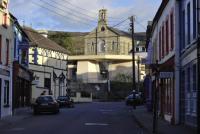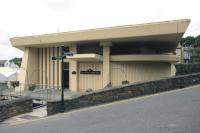Bantry Library, Co. Cork
Published in
20th-century / Contemporary History,
Gems of architecture,
General,
Issue 1(Jan/Feb 2013),
Volume 21

From Bridge Street the library appears to have only one roof, placed like the capping stone on a wedge tomb, held up by two great Egyptian pylons. (NIAH)
Set in the small market town of Bantry, surrounded by one of the spate rivers that drain from the Knocknaveagh range to the south, is one of Ireland’s most unusual examples of Modernist architecture. Bantry Library was designed in 1962 by the Cork County Council architect Patrick McSweeney, and the project was developed and overseen by his assistant, Harry Wallace. The design is said to have been conceived when McSweeney and his daughter were recovering from the ’flu; to pass the time he made a model of a library building. His excitement with this design led him to present the model to a Convention of Librarians in Dublin, where it was enthusiastically received.
Four years passed before plans were ready for public consultation, and four more before funding was secured. The cost was estimated at £45,000 (it would ultimately cost £60,000)—a significant sum at the time, and the cause of some controversy. At a heated meeting of Bantry Town Commissioners, one councillor was quoted as saying that ‘it would be nothing short of ridiculous to throw that sum of money into that dump’ and ‘it would be far better to cover in the river, make a car park there and widen the road’. More sympathetic was R.P. Keyes, who warned that if Bantry were to say no the money would inevitably go elsewhere, and just as the town had refused a library offered by the Carnegie Trust in 1912, they would soon regret this kind of shortsightedness too. The proponents succeeded and the library was built in 1972–4.
The great joy of the library is its romantic interpretation of an array of both ancient and modern sources, from standing stones to Corbusier’s Nôtre Dame du Haut, from battered Egyptian pylons to Wright’s Falling Water, and even the sweeping curve of a Martello tower, all rendered in ‘oatmeal’ concrete. Local opinion holds that McSweeney used the megalithic wedge tomb as the principal source for his design, translating its trabeated forms into mass concrete. Indeed, the architect, who grew up in the nearby village of Ballydehob, must have been aware of the high density of such monuments in the local area. In reality, however, Ireland’s ancient heritage was just one of the sources on which McSweeney drew.

A bridge (bottom left) connects the road with the library. (NIAH)
From Bridge Street the library appears to have only one roof, placed like the capping stone on a wedge tomb, held up by two great Egyptian pylons. The river cascades around the building, its successive waterfalls separating the library from the steep road nearby; a bridge connects the road with the library. A columnar screen surrounds the entrance, like a series of standing stones, with a large projecting canopy. On the south façade a fluted sweep of concrete resembles a Martello tower. Further around the building there are two large windows with glass from floor to ceiling, divided by a bulky pier supporting a bold concrete gargoyle.
The interior is one large space, with the exception of a bathroom and two small offices. The roof is full height above the main bookshelves but lower in the reading, children’s and reference areas. The most exciting view is found above the children’s area, where deep light cannons bind the main and subsidiary roofs together. Dramatic in a very different way are the light cannons above the main bookshelves, which are suspended at seemingly random heights. These were originally designed to be square in section, painted in primary colours, and to have formed an equally dramatic cityscape-like skyline of differing heights on the exterior of the roof. Budget concerns, however, saw the use of pre-cast concrete pipes instead.
McSweeney is best known in Ireland for designing Cork County Council’s tower-block headquarters, County Hall (1968). He and Wallace also designed Fermoy Library (1970), a less monumental combination of Egyptian pylons and concrete gargoyles. Bantry, which he thought his best work, was his last for the Council. In his later Church of the Incarnation (1974–6), Frankfield-Grange, Co. Cork, we can see some of Bantry’s monumentality. Unlike this brick church, both Bantry and Fermoy libraries have been repeatedly painted. McSweeney’s uncompromising Brutalist aesthetic may have been too much for small-town Bantry. HI
Richard Butler is pursuing a history of early nineteenth-century Irish public architecture at the Department of History of Art and Architecture, University of Cambridge. Series based on the National Inventory of Architectural Heritage’s ‘building of the month’, www.buildingsofireland.ie.


















